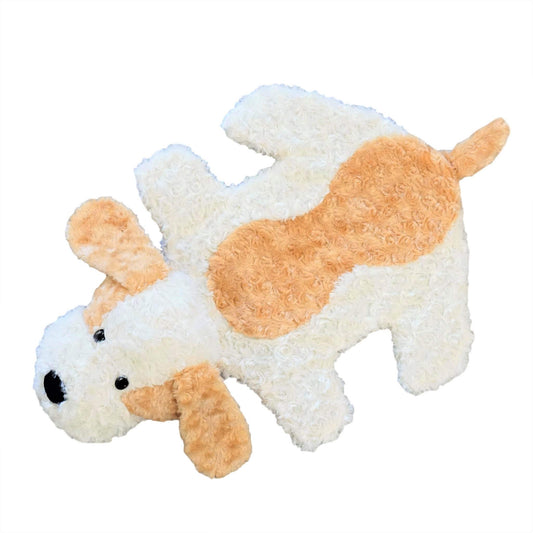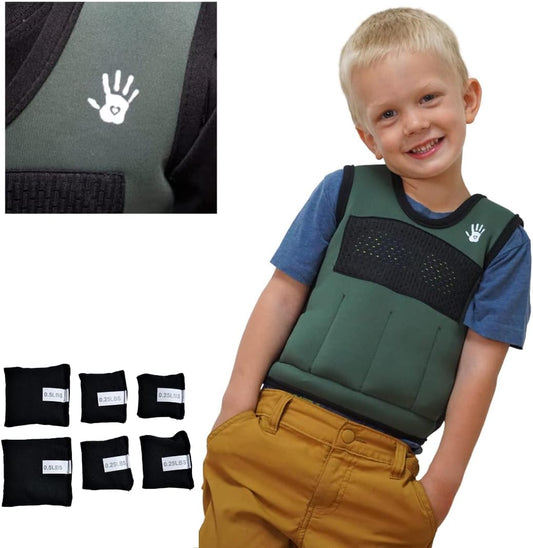Introduction:
Autism spectrum disorder (ASD) is a developmental disability caused by differences in the brain. People with ASD often have problems with social communication and interaction. Kids with ASD may also have different ways of learning, moving, or paying attention.
Weighted vests are sometimes used as a sensory tool for individuals (kids/adults) with Autism Spectrum Disorder (ASD). Kids with autism often experience sensory processing difficulties, which can affect how they understand and respond to sensory stimuli in their environment. These sensory challenges may include hypersensitivity to touch, proprioception, and vestibular input.
Wearing a weighted vest provides deep pressure input to the body, which is believed to have a calming and organizing effect on the nervous system. This is known as “Deep Pressure Therapy”. The pressure from the weighted vest is to help regulate sensory processing, reduce anxiety, and improve attention and focus.
How long should an autistic child wear a weighted vest?
There are no clear rules on how long a weighted vest can be worn. It is best to consult with the child's therapist to plan a “wearing schedule” that the child will get used to without much difficulty.
The duration for which an autistic child should wear a weighted vest can vary depending on the individual child's needs and preferences. Typically, the use of a weighted vest is recommended for short periods, such as 20 to 60 minutes, and is often introduced into a child's sensory diet or therapy plan.
The goal is to provide the child with sensory input that can help improve attention, focus, and self-regulation. Always seek guidance from professionals who are familiar with the child's specific sensory profile and can provide authentic recommendations based on their assessments.
Does a weighted vest help autistic kids?
The use of weighted vests for children with autism is a topic that has been explored, but it is essential to note that the effectiveness of such interventions varies from child to child. Some parents and professionals report positive outcomes, while others may not observe significant benefits.
Therapists recommend weighted vests to children with autism to provide deep touch pressure to help them relax and focus during a classroom activity. There is no solid evidence that it helps reduce autism in a child, but therapists have noted a decrease in this behavior when a weighted vest is worn. Therefore, that is a good sign.
Outside the field of research, teachers and therapists using weighted vests on children with autism is already a common and accepted practice. Always consult with healthcare professionals who are familiar with the child's specific needs before implementing any interventions.
Can you get a prescription for a weighted vest?
A prescription for a weighted vest would be obtained through consultation with a healthcare professional, such as a doctor or physical therapist. They can evaluate your child’s individual needs, medical history, and any existing conditions to determine whether a weighted vest is a suitable option for your child. If they believe it is appropriate, they can provide you with a prescription or a recommendation for obtaining a weighted vest. Weighted vests are sometimes recommended for certain medical conditions or during rehabilitation programs.
Are weighted vests good for autism?
The idea behind using weighted vests for autism is rooted in sensory integration theory, which suggests that providing sensory input can help individuals regulate and organize their sensory experiences. Weighted vests are designed to provide deep pressure input, which can have a calming effect on the nervous system for some individuals.
Here are some potential benefits that individuals with autism may experience when using weighted vests. These are mentioned below:
- Calming Effect: Deep pressure stimulation can have a calming and organizing effect on the sensory system, helping individuals to self-regulate.
- Improved Focus and Attention: Some individuals with autism may find that the added sensory input helps them stay more focused and attentive, especially in situations where sensory stimulation may be overwhelming.
- Reduced Anxiety: The deep pressure provided by the weighted vest may help reduce anxiety.
- Enhanced Body Awareness: Weighted vests can contribute to improved body awareness, which is the sense of the body's position in space.
“It is essential to monitor the individual's response and make adjustments as needed. It's also important to consider individual preferences and comfort levels when introducing sensory tools like weighted vests.”
Does Insurance cover a weighted vest?
Whether a weighted vest is covered by insurance depends on various factors, including the type of insurance you have and the specific circumstances surrounding the vest. These are mentioned below:
- Health Insurance: Health insurance typically covers medical expenses related to a diagnosed condition or illness. If a weighted vest is recommended by a healthcare professional as part of a treatment plan for a medical condition, there may be a possibility of coverage.
- Durable Medical Equipment (DME) Coverage: Some insurance plans may cover certain types of durable medical equipment, and a weighted vest might fall into this category if it is prescribed for a medical purpose. It is important to check with your insurance provider to determine coverage.
- Therapy or Rehabilitation Coverage: If the weighted vest is recommended by a physical therapist, occupational therapist, or another healthcare professional, there may be a chance that insurance will cover it.
“It is essential to contact your insurance provider directly to inquire about coverage for a weighted vest.”
What is the appropriate weight for a weighted vest?
A weighted vest should not weigh more than 10 percent of your body weight. Research has suggested that weighted vests should be around 8-10 percent of your body weight. The appropriate weight for a weighted vest depends on several factors, including your fitness level, goals, and the type of exercise you plan to perform. Here are some general guidelines to help you choose the right weight for a weighted vest:
Fitness Level:
- Beginners: If you are new to exercising or using a weighted vest, start with a lighter weight, such as 5% to 10% of your body weight.
- Intermediate/Advanced: If you have some fitness experience, you can choose a weight of around 10% to 15% of your body weight.
Goals:
- Strength and Endurance: If your goal is to build strength and endurance, a heavier vest may be appropriate. Aim for a weight that challenges you but allows you to maintain proper form during exercises.
- Cardiovascular Fitness: For activities like walking, jogging, or hiking, a lighter vest may be more suitable to increase the intensity without compromising your form.
Comfort and Safety: Ensure that the weighted vest is adjustable and fits comfortably. This helps prevent excessive movement during exercises.
Pay attention to how your body responds to the added weight, and if you experience any discomfort or pain, consider reducing the weight
Why do neurodivergent people like weighted blankets?
Weighted blankets are often favored by neurodivergent individuals for several reasons. There are some common reasons why neurodivergent individuals, such as those with autism, ADHD, anxiety, or sensory processing disorders, may find comfort in weighted blankets. These are mentioned below:
- Deep Pressure Stimulation (DPS): Weighted blankets provide a form of deep pressure stimulation, which involves gentle, evenly distributed pressure across the body. This pressure is believed to promote the release of serotonin and dopamine, neurotransmitters associated with feelings of well-being and relaxation. It also promotes a sense of calmness.
- Sensory Regulation: Weighted blankets can provide a consistent, calming input that helps regulate sensory issues. The added weight can be soothing and provide a sense of security, making it easier for some individuals to filter out excessive stimuli.
- Improved Sleep: Many neurodivergent individuals experience sleep difficulties. Weighted blankets help in improving sleep quality by creating a comforting and secure environment. It is particularly beneficial for those with conditions such as autism or ADHD that may be associated with sleep challenges.
- Anxiety Reduction: Anxiety is a common experience for many neurodivergent individuals. The deep pressure provided by a weighted blanket can reduce the feeling of anxiety and provide comfort.
“It is important to recognize that individual responses to weighted blankets can vary. While many neurodivergent individuals find them beneficial, others may not. It is always advisable to consider personal preferences and consult with healthcare professionals”.
Conclusion:
From the above-mentioned article, it can be concluded that weighted vests can be of vital importance in terms of fighting several disorders being faced by many kids these days. Therefore, the right weighted vest and prescribed time can help cure ADHD and autism.





